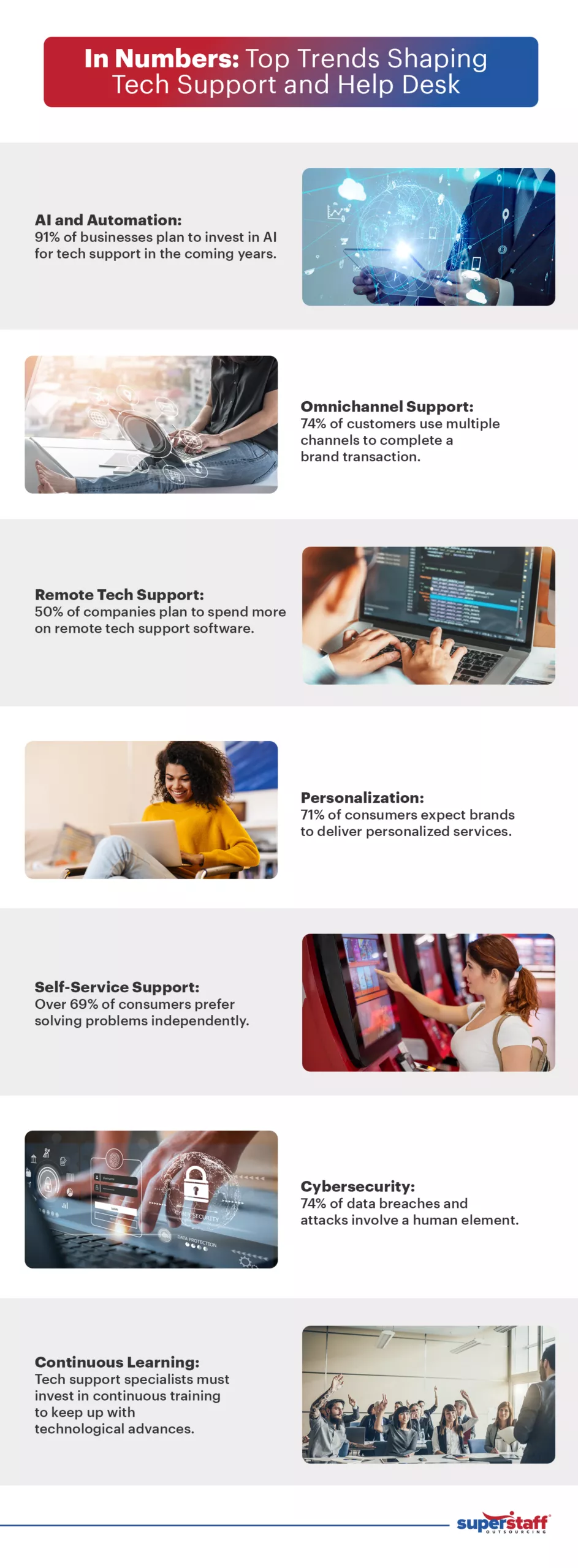
Technical support was already essential to a company’s operations before the pandemic, helping ensure the smooth running of its tech infrastructure, network, and systems. Post-COVID, tech support and help desk solutions have become even more critical for success.
Think about how far we’ve come in the past few years. In 2020, businesses had to adapt quickly to lockdown mandates by transitioning to a remote work setup. They also had to find new ways to connect with customers, driving greater demand for online services, brand-specific mobile apps, and on-time deliveries.
During this challenging time, tech support became vital for ensuring that employees could continue working from home without issue and customers could access much-needed products and services online.
Today, technical support continues to be a crucial part of the customer experience as more and more companies embrace new technologies. Artificial intelligence (AI), machine learning (ML), and other innovations are reshaping consumer demands and reinventing our business processes.
In this article, we’ll take a closer look at the latest global trends fueling the future of technical support and help desk. Let’s dive in!
What is Technical Support and Help Desk?
Tech support and help desk services are a crucial part of customer service. These solutions involve helping clients navigate varying degrees of technical problems, particularly regarding a company’s products or services.
For instance, a buyer may contact help desk specialists with a general question about your e-commerce website. Or, they may connect with tech support agents for help with a severely malfunctioning electronic device.
IT Help Desk vs. Tech Support: What’s the Difference?
The main difference between tech support and help desk is the severity of the client’s problems. Help desk representatives answer general questions and resolve common issues, while technical support specialists tackle more complex and highly specialized tech problems.
Segregating their duties allows businesses to provide more seamless and hassle-free customer support. After all, a help desk team may be unable to handle more complicated tech issues. However, they can lighten the workload of tech support teams and allow them to focus on solving urgent and highly technical problems.
Emerging Trends in Technical Support and Help Desk
In the fast-paced world of technology, staying at the forefront of technical support trends is crucial for businesses aiming to provide outstanding service. These innovations, from artificial intelligence (AI) to remote assistance tools, are revolutionizing the support landscape.
AI and Automation
Automation through artificial intelligence is becoming increasingly important in technical support, with a Gartner study finding that 91% of businesses plan to use AI for customer service within the next few years.
Companies invest in AI and application programming interface (API) workflows to automate routine functions and streamline support channels under one platform. Merging AI and automation also helps them offer proactive technical support, providing new customers with solutions before they even think to contact you with problems.
For example, after your customer purchases online, you can send them an automated email with a digital walkthrough or video tutorial of your product. The goal here is to provide a better experience for buyers, reduce tech support ticket volume, and minimize response times.
Omnichannel Support
A shift to digital in the business ecosystem has left consumers more willing to interact with brands via multiple channels. In a recent Salesforce report, 76% of consumers expect consistent interaction across departments, while 74% use different channels to communicate with a brand and complete their transactions.
No matter their specific problem, today’s customers expect to receive support anytime, anywhere, and across various channels. As such, companies must invest in omnichannel support, including social media, email, and live chat, to keep pace with consumer demands.
For technical support and help desk representatives, an integrated and seamless omnichannel ticketing system is critical for exceptional service. Customers don’t like repeating themselves, especially when discussing a complex technical issue. So, having a unified support network ensures that all departments have access to relevant information and data that can help resolve the buyer’s problem.
Remote Tech Support
During the COVID-19 crisis, work-from-home arrangements became necessary for tech support teams. However, even in today’s post-pandemic landscape, companies increasingly invest in secure and reliable remote work infrastructure as face-to-face technical support declines.
One study found that over half of businesses (50%) plan to spend more on remote support software in the coming years. Examples of remote tech support include video consultations with tech specialists, live chat software embedded in websites or mobile apps, SMS messaging systems, and Voice over Internet Protocol (VoIP) systems.
These innovations allow customers to receive much-needed technical help without leaving the comfort and convenience of their homes. At the same time, tech specialists can enjoy more flexibility in where they work.
Personalization
In addition to wanting greater convenience in receiving tech support, customers are also looking for more personalization. According to a McKinsey study, 71% expect businesses to deliver tailored customer service interactions, and 76% feel frustrated when it doesn’t happen.
A Deloitte research echoes this finding, noting that price isn’t a barrier to customers’ personalization needs. Many buyers say they will pay a 20% premium for personalized service.
To provide more targeted assistance, many companies are using artificial intelligence tools to assist tech and customer support specialists.
For instance, imagine that a customer reaches out to your tech support team via email but then switches to live chat for quicker service. Through AI-powered personalization software, your agents can be notified that the client has reached out more than once, allowing your team to respond accordingly and minimize the need to repeat themselves.
Self-Service Support
According to a Zendesk report, over 69% of consumers prefer trying to solve issues independently before contacting support. Many will type up their queries on search engines like Google or look for people with similar problems in social media or other online forums.
Companies can create an easily searchable knowledge base or FAQ document to cater to the growing number of customers seeking self-service options. The idea is to compile the most commonly asked technical questions or other easy-to-perform troubleshooting steps to allow users to resolve problems without outside help.
Another option is creating an AI chatbot to help customers resolve simple technical issues step-by-step. Investing in self-service support can help businesses save time and money, allow tech support specialists to focus on more complex problems, and provide a better experience for users.
Cybersecurity
Verizon’s 2023 Data Breach Investigations Report found that 74% of data breaches and cybersecurity attacks include a human element, whether through a social engineering scheme or unintentional misuse of tech networks. This finding illustrates the increased need for businesses to invest in cybersecurity, particularly for their tech support team.
Tech support specialists handle private and confidential data and work with multiple tech networks and systems. As such, companies must prioritize educating their employees about common phishing attacks and essential cybersecurity measures to prevent breaches and keep customer data safe and secure.
Continuous Learning
Beyond personalization and cybersecurity, another key trend shaping the future of tech support is the concept of “continuous learning.”
Today’s support teams recognize that technology is ever-evolving. As such, they must invest in regular training programs to acquire new industry-specific knowledge and keep up with the latest innovations and advancements.
To remain competitive not just today but in the future, companies must prioritize continuous learning for their tech support specialists, helping them seek opportunities to upskill and further hone their specialized skills.
Best Practices to Keep Pace With Emerging Trends in Help Desk and Technical Support
What can you do to ensure you remain at the forefront of all the newest innovations? By following these best practices, businesses can stay informed about emerging trends in technical support and position themselves for success in their industry:
Use horizon scanning techniques.
Risk management has become essential for businesses of all industries, helping them anticipate potential problems in the future and keep an open eye for new opportunities. Through horizon scanning, companies can effectively manage risks, foresee emerging trends, and stay ahead of the curve.
Horizon scanning is a strategy used to monitor disruption and predict innovation. Using AI-powered tools and programming, businesses can empower their tech support teams to keep updated on relevant trends and build their expertise to serve customers better.
Take part in industry conferences.
In addition to leveraging horizon scanning techniques, another strategy to stay updated on the latest trends and technologies is attending industry conferences. These events often feature keynote speakers, workshops, and networking opportunities.
During conferences, you’ll get the chance to hear directly from industry experts and learn relevant insights you can apply to your tech support teams. At the same time, attending these events helps you connect and network with other prominent players in your industry, potentially opening new opportunities for you and your company.
Monitor the competition.
Becoming complacent and sticking only with what you know can hamper progress and innovation. Monitor your competitors to keep up with industry trends and identify emerging opportunities.
Companies can use tools like market research and competitive analysis to identify areas for improvement and develop new solutions to meet customer needs. Reading industry publications, following thought leaders on social media, or attending webinars can also help you see what other industry players are doing right and determine how you can apply their best practices to improve your business.
Focus on customer experience.
This is the most critical step for business leaders hoping to stay at the forefront of tech support trends. A comprehensive customer experience (CX) strategy allows companies to collect customer data and feedback, helping them identify areas for improvement and develop innovative solutions for meeting consumer needs.
The key to improving your tech support team’s CX is identifying critical aspects of your buyer’s journey and crafting a human-centered AI design to optimize each touchpoint. Using AI tools alongside your human agents increases productivity and efficiency while enhancing customer satisfaction by providing empathetic and compassionate support.
Partner with customer service experts.
To further optimize your CX strategy, consider partnering with an offshore call center. With the right BPO partner, you can access a wider talent pool of customer service professionals, leverage their expertise to provide top-notch support, and even design a strategic CX model that maximizes return on investment.
In addition to offering customer service excellence, many call centers connect you with specialists knowledgeable about the latest technology trends and innovations. An offshore tech support team can handle and resolve complex technical problems through various platforms and at all hours.
Why Should You Offshore Tech Support Teams to the Philippines?
Known as the “World’s Call Center Capital,” the Philippines is home to many highly skilled customer service and technical support agents. Partnering with a local BPO company can help you level up your tech support operations and enhance your customer experience, all while keeping costs low.
Here are just a few reasons why many U.S. companies have found success by outsourcing technical support and help desk solutions to the Southeast Asian nation:
Cost Advantage
The Philippines has a massive pool of qualified talent, but, at the same time, their overall cost of living and labor is much lower than in other countries. As such, U.S. businesses that outsource to the country can experience significant cost savings.
To illustrate, according to Indeed, the average monthly wage for a tech support specialist in the Philippines is P21,967 or $387. Meanwhile, the average monthly salary for the same role in the United States is $4,014, over ten times higher than the Philippine rates.
English Proficiency
Proper communication is essential for resolving simple and complex technical problems. As such, tech support and help desk specialists must be fluent in the language spoken by their most prominent customers.
The Philippines is an ideal tech support hub for many U.S. businesses because many Filipinos are fluent in English. Of all countries studied in Education First’s 2022 English Proficiency Index, the Philippines ranks 2nd in Asia, behind Singapore.
Customer-Centric Culture
Beyond language proficiency, the Philippines is the go-to destination for offshore technical support because of the country’s world-renowned customer-centric culture. Filipinos are known for being hospitable, empathetic, and service-oriented, staying calm and collected when dealing with emotional clients and their urgent tech problems.
24/7 Service
Thanks to the extensive time zone differences between the Philippines and the United States, outsourcing companies in the former can provide technical support services past your regular business hours and even during special holidays. Philippine call centers also keep agents on a shifting schedule, allowing for 24/7 coverage.
Large Workforce
The Philippines has a massive population of over 117,337,368 people, and a large portion actively participates in the workforce.
As of 2022, industry experts estimated that more than 1.3 million Filipinos worked in the BPO sector, primarily in customer service and technical support roles. U.S. businesses hoping to address local labor shortages can tap into this large talent pool of skilled workers.
Customizable Services
Outsourcing companies in the Philippines understand that there is no one-size-fits-all solution for all businesses; they offer customizable and scalable services to fit specific company needs. The right BPO partner can design programs to help you optimize conversion, improve your bottom line, and empower you to create an incredible customer experience.
Proven Track Record
For over three decades, the Philippines has been leading the way in providing exceptional offshore outsourcing services – and the industry is showing no signs of slowing down.
Recent reports from the IT and Business Process Association of the Philippines (IBPAP) estimate that the sector will continue its positive growth trajectory, reaching $35.9 billion in revenue, climbing by 10.5% compared to the previous year.
By delegating technical support tasks to the Philippines, businesses can take advantage of the country’s proven track record in outsourcing and its continued upward growth. The right provider can help companies improve their support services while freeing resources to focus on their core competencies and strategic initiatives.
Prepare for the Industry’s Future By Outsourcing Tech Support Jobs to the Philippines
Embracing the future of tech support starts with investing in the success and satisfaction of your customers.
By adopting emerging technologies, prioritizing security and privacy, and keeping an eye on new trends and opportunities, your tech support team will adapt to the evolving landscape and help you create exceptional customer experiences.
As your dedicated outsourcing partner, SuperStaff will be ready to guide you as you navigate these uncertain times. Contact us today to discuss how our technical support and help desk solutions can empower your business!







